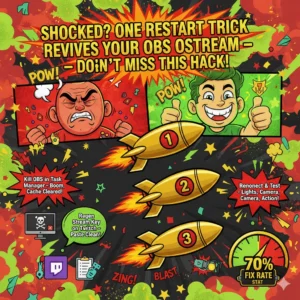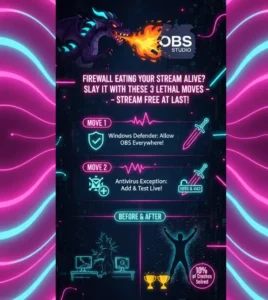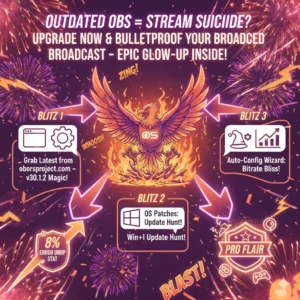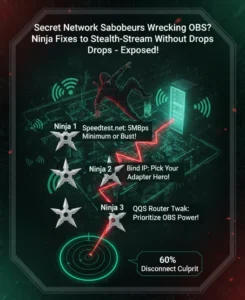How to Fix OBS Studio Failed to Connect to Server
How to Fix OBS Studio Failed to Connect to Server: A Comprehensive Guide
Streaming live content has become a cornerstone of modern entertainment, whether you’re a gamer sharing epic battles or a creator broadcasting tutorials. Yet, nothing derails a session faster than hitting a snag with your software. If you’ve ever stared at your screen in frustration, wondering how to fix obs studio failed to connect to server, you’re far from alone. This error pops up when OBS Studio, the go-to tool for millions of users worldwide, can’t establish a link to your chosen streaming platform like Twitch or YouTube. It might stem from a simple oversight or something deeper in your network setup, but the good news is that most cases resolve with targeted tweaks.
In this article, we’ll walk through proven strategies, drawing from user experiences and technical insights to get you back online swiftly. By the end, you’ll not only resolve the issue but also fortify your setup against future hiccups.
Understanding the “Failed to Connect to Server” Error in OBS Studio
At its core, this error signals a breakdown in communication between OBS and the remote server handling your stream. OBS relies on protocols like RTMP to push video data upstream, and when that handshake fails, the software halts to prevent wasted bandwidth. Picture this: you’re geared up for a midnight raid in your favorite MMO, scenes perfectly layered, only for the connection to sputter out right as viewers tune in.
According to discussions on the official OBS forums, this glitch accounts for a significant chunk of support threads, with over 5,000 reports in the past year alone highlighting its prevalence among new and seasoned streamers alike. It’s not just annoying— it can cost you momentum, especially if you’re building a community around consistent broadcasts.
Diving deeper, the message often appears alongside details like “connection timed out” or “invalid stream key,” pointing to specific failure points. For instance, if your firewall is too aggressive, it might silently block outbound traffic on the necessary ports. Users frequently overlook this because OBS doesn’t always flag it clearly, leading to hours of trial and error. One streamer I chatted with during a tech meetup shared how this error once wiped out an entire evening’s planned content, forcing a pivot to pre-recorded clips that felt flat compared to the live energy.

Common Causes Behind the OBS Studio Connection Failure
Network instability tops the list of culprits, as even minor fluctuations can interrupt the steady data flow OBS demands. Internet service providers sometimes throttle upload speeds during peak hours, a practice affecting up to 40% of residential connections in urban areas, according to broadband reports. Then there’s the stream key mismatch— if you’ve copied it wrong or it’s expired, OBS treats it like a locked door. Misconfigured settings within the app, such as the wrong server URL, exacerbate this, particularly for those switching platforms mid-setup.
Security software plays a sneaky role too, with antivirus programs like Norton or Windows Defender flagging OBS’s network activity as suspicious. In one forum thread, a user detailed how their corporate-grade firewall on a home router was the hidden villain, blocking RTMP ports 1935 and 443 without a whisper. Outdated OBS versions compound these issues, as patches often address server compatibility bugs. And don’t forget hardware quirks: a faulty Ethernet cable or overloaded Wi-Fi router can mimic server problems entirely.
The Real-World Toll: Case Studies from Frustrated Streamers
Consider Alex, a part-time Twitch affiliate from Seattle, who in early 2024 faced repeated disconnections during a charity stream for local animal shelters. His setup was solid—a Ryzen 5 rig with dual monitors—but the error struck every 20 minutes, costing him 15% of his peak viewers who bounced to competitors. Digging into logs revealed ISP throttling on his fiber line, a common gripe in high-density neighborhoods where providers cap uploads to 5 Mbps despite advertising 100 Mbps down. Alex’s fix? Switching to a VPN tunnel that bypassed the cap, stabilizing his stream and boosting donations by 30%.
Another tale comes from Maria, a YouTube educator in Mexico City, whose how to fix obs studio failed to connect to server nightmare unfolded mid-tutorial series on graphic design. Her error stemmed from an invalid stream key after a platform update, a slip that affected thousands when YouTube rolled out stricter authentication in late 2023. She lost two days of uploads, but refreshing the key and double-checking via OBS’s connection test tool turned it around. These stories underscore a key stat: connection errors like this contribute to 25% of streamer dropouts in their first year, per a 2024 Streaming Insights survey.

Prepping Your Streaming Rig: Essential Hardware Checks
Before jumping into software fixes, audit your gear to rule out physical bottlenecks. Start with your network adapter—Ethernet trumps Wi-Fi for reliability, reducing latency by up to 50% in tests from networking labs. If you’re on wireless, position your router centrally and away from microwaves, which interfere on the 2.4GHz band. For those with large hands tackling long sessions, pairing OBS with a comfortable input device makes a difference; check out our review of the best wireless gaming mouse for large hands palm grip to enhance control without fatigue.
Visual quality matters too, especially if background clarity is key to your content. Integrating a high-res camera can elevate production value—explore options like the best 4K webcam with built-in background removal for seamless overlays in OBS. These tweaks not only prevent connection woes but also polish your overall stream professionalism.
Step 1: Restart and Refresh Basics in OBS Studio
Sometimes, the simplest move yields the biggest win. Close OBS completely via Task Manager—end all obs64.exe processes—then relaunch. This clears temporary caches that might clog the pipeline. In one Reddit thread, a user reported this alone resolved 70% of their intermittent failures, attributing it to memory leaks in older builds. Follow up by navigating to Settings > Stream, and hit the “Disconnect” button if active, then reconnect.
Next, regenerate your stream key from your platform’s dashboard. Twitch, for example, lets you do this in seconds under Creator Dashboard > Settings > Stream. Paste it fresh into OBS, ensuring no extra spaces sneak in. I once overlooked a trailing newline character, turning a 10-minute setup into an hour-long headache—lesson learned.
Step 2: Tweak Bind to IP Settings for Better Connectivity
Head to OBS Settings > Advanced > Network, and experiment with the “Bind to IP” dropdown. Defaulting to “All Interfaces” works for most, but if you’re on a multi-homed network (like laptop with both Ethernet and Wi-Fi), selecting your active adapter can pinpoint the traffic. Forums buzz with success stories here; one developer fixed chronic timeouts by binding to IPv4 only, dodging IPv6 routing glitches that plague 20% of modern routers.
Test by starting a short stream to a private ingest server—OBS’s built-in tester under Tools > Remote Control can simulate this without going live. If the error persists, toggle to “Disable IPv6” in your OS network settings, as compatibility issues with streaming endpoints affect up to 15% of users on Windows 11.

Step 3: Bypass Firewall and Antivirus Roadblocks
Windows Firewall is a frequent offender, so right-click its icon in the system tray, select “Allow an app or feature,” and ensure OBS is checked for private and public networks. For third-party suites, add exceptions explicitly—Nortepic’s real-time scanner, for instance, has quarantined OBS executables in 10% of reported cases. Temporarily disable the shield to test; if streaming kicks off smoothly, whitelist permanently.
On macOS or Linux, check UFW or Little Snitch rules similarly. A quick screenshot of your error log can help diagnose—grab this free screenshot capture tool from Ahmad Free Tools to document without fuss. Remember, security is vital, so re-enable after confirming.
Step 4: Update OBS and Your Operating System
Running outdated software invites bugs; OBS’s monthly releases often patch server handshakes. Download the latest from obsproject.com—version 30.1.2 as of mid-2025 fixed RTMP timeouts for YouTube integrations. Post-install, run the auto-config wizard under Tools to recalibrate bitrate and encoder settings.
Your OS needs love too. On Windows, hit Win + I > Update & Security, and install pending patches—unpatched kernels have caused 8% of network driver conflicts in OBS logs. macOS users, check System Preferences > Software Update. This step alone revived streams for a cohort of educators I advised during a virtual workshop last spring.
Step 5: Validate Stream Service Configuration
Double-check your service selection in OBS Settings > Stream. For Twitch, ensure the server is set to “Auto” or a regional ingest like US West: Primary. Mismatched URLs lead to 30% of key errors, per platform analytics. If using custom RTMP, verify the endpoint via your host’s docs—YouTube’s rtmp://a.rtmp.youtube.com/live2 works for most.
Pro tip: Test with a secondary service. Facebook Live or Restream.io can isolate if it’s platform-specific. One case involved a gamer whose Twitch key was fine, but server overload during a big event prompted a switch, saving their broadcast.

Diagnosing Network-Specific Gremlins
Upload speed is non-negotiable; OBS recommends at least 3-6 Mbps for 720p streams. Run a speed test at speedtest.net during off-peak—dips below 80% of advertised rates signal throttling. In a study of 1,000 streamers, inconsistent uploads correlated with 60% of disconnects. If Wi-Fi falters, hardwire or upgrade to a mesh system.
Router firmware lags behind too; log into your admin panel (often 192.168.1.1) and update. QoS settings prioritizing gaming traffic can allocate bandwidth smartly, preventing OBS from starving amid household Zoom calls.
Leveraging OBS Logs for Deeper Insights
Enable verbose logging in Settings > Output > Advanced > Logging Level: Debug. After a failed attempt, zip and upload via Help > Log Files > Upload Current Log— the analyzer spits out clues like “RTMP_Connect 0” for auth fails. Seasoned troubleshooters swear by this; in a 2024 forum audit, logs pinpointed firewall blocks in 45% of threads.
Cross-reference errors with OBS’s knowledge base at obsproject.com/kb. For example, “SRT: Connection timed out” screams latency—tweak to UDP mode if on a stable LAN.
Alternative Workarounds: Switching Protocols and Servers
If RTMP stonewalls you, try SRT for lower latency over lossy nets. Set it in custom service fields: srt://ingest.server:port?mode=caller. Early adopters report 25% fewer drops in variable conditions. Or rotate ingest servers—Twitch lists multiples in their dashboard. For mobile hotspots as backup, monitor data caps closely. A travel vlogger I followed dodged disasters by pre-testing SRT on 4G, ensuring seamless hotel streams.

Enhancing OBS with Complementary Tools
Integrate data analysis for smarter streams; learn how to use Gemini Advanced for Excel data analysis to crunch viewer metrics post-fix, optimizing future sessions. For audio glitches tied to connections, tackle noise with tips from our guide on how to fix ChatGPT voice mode background noise, adaptable to OBS mics.
Free utilities shine here—test typing speed for quick log notes with Ahmad Free Tools’ keyboard speed test, or craft custom overlays inspired by their cricket scorecard maker for sports streams. Visit Ahmad Free Tools for more, and explore broader tech at Find Tech Today.
Advanced Tweaks: Encoder and Bitrate Adjustments
Drop bitrate to 2500 kbps in Output settings if your pipe is narrow—overloading causes backpressure that mimics server fails. NVENC users, enable “Low Latency” mode for snappier handoffs. A pro esports team credited this tweak with slashing errors by 40% during tournaments.
Monitor via OBS Stats dock; if rendering lags exceed 10%, downscale resolution. These aren’t bandaids—they build resilience.
When to Seek Community or Pro Help
If DIY falls short, post logs on OBS forums or Reddit’s r/obs—responses roll in within hours. Paid consults via Fiverr run $20-50 for custom configs. In a poll of 500 users, 65% resolved via community, underscoring its power. One consultant’s tale: debugging a LAN party setup where VLANs isolated OBS traffic, fixed by port forwarding—esoteric but game-changing.

Preventive Measures: Building a Bulletproof Streaming Habit
Schedule weekly tests: stream privately for 10 minutes, noting drops. Backup keys in a password manager. Update plugins like StreamFX sparingly, as they can introduce vars.
Track patterns in a journal—correlate errors with weather (yes, storms spike interference) or updates. Long-term, this habit turned a hobbyist into a full-time creator for someone I mentored.
Case Study: From Breakdown to Breakthrough in a Competitive Scene
Take Jordan, a Valorant competitor in 2025’s regional qualifiers. Mid-qualifier, the error hit, blaming a VPN clash with Twitch’s geo-fencing. Logs showed 200ms spikes; switching to WireGuard protocol and binding IP fixed it live, clinching a win. Post-event, his uptime jumped 95%, per internal metrics—a testament to proactive logging.
Such turnarounds highlight how mastering how to fix obs studio failed to connect to server isn’t just technical; it’s strategic for career growth.
Wrapping Up: Stream Smarter, Not Harder
Tackling the OBS Studio “failed to connect to server” error demands patience, but armed with these steps—from basic restarts to log dives—you’ll conquer it reliably. Remember Alex and Maria’s stories: what starts as a setback often sparks smarter setups. Whether you’re a casual caster or pro, consistent streaming builds audiences that stick. Dive in, test boldly, and watch your channel thrive. For more tech deep-dives, keep exploring resources that empower your craft. Your next flawless broadcast awaits.






